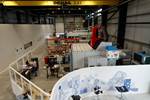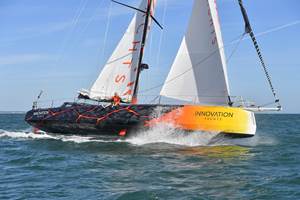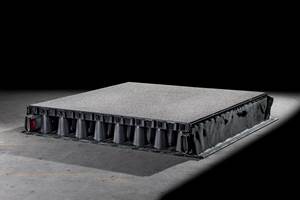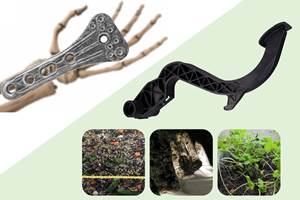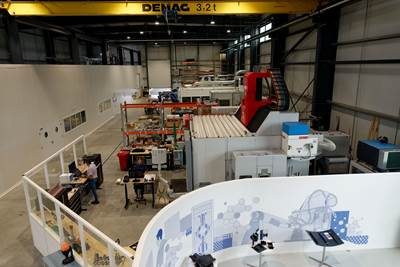GE, COBOD, LafargeHolcim enable taller wind turbines with 3D-printed concrete base
3D-printed bases can be printed on-site and will enable production of wind turbines up to 200 meters in height.
Share
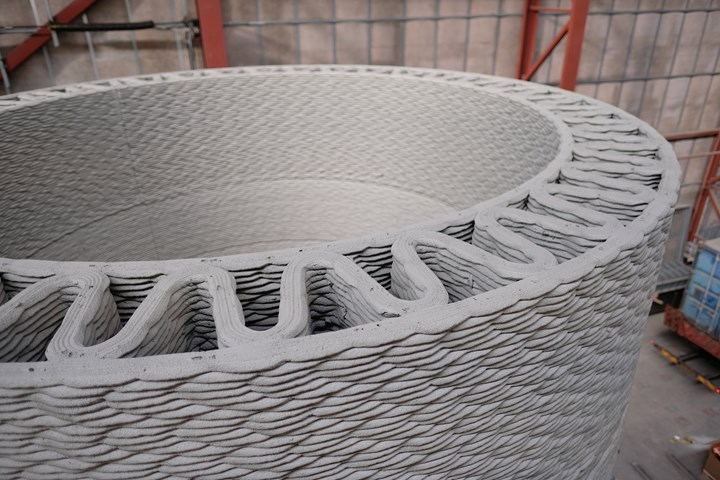
Top of 3D-printed wind turbine concrete base. Source | GE Renewable Energy, COBOD, LafargeHolcim
(Paris, France), (COBOD International A/S, Copenhagen, Denmark) for robotic 3D construction printers and automated processes for building sites and concrete providers, (Zug, Switzerland) announced on June 17 that they plan to undertake a multi-year collaboration to develop optimized 3D-printed concrete bases for wind turbines, which are expected to reach record heights of 200 meters. The partnership, in addition to increasing renewable energy production, lowering the levelized cost of energy (LCOE) and improving construction costs, is said to produce a wind turbine prototype with a printed pedestal, as well as a production-ready printer and materials range to scale up production. The first prototype, a 10-meter high tower pedestal, was successfully printed in Copenhagen, Denmark in Oct. 2019. By exploring ways to economically develop taller towers that capture stronger winds, the three partners aim to generate more renewable energy per wind turbine.
It is said that GE will provide expertise related to the design, manufacture and commercialization of wind turbines, COBOD will focus on the robotics automation and 3D printing and LafargeHolcim will design the tailor-made concrete material, its processing and application.
“3D printing is in GE’s DNA and we believe that Large Format Additive Manufacturing [LFAM] will bring disruptive potential to the wind industry,” says Matteo Bellucci, Advanced Manufacturing Technology leader for GE Renewable Energy. “Concrete printing has advanced significantly over the last five years and we believe it is getting closer to having real application in the industrial world. We are committed to taking full advantage of this technology both from the design flexibility it allows, as well as for the logistic simplification it enables on such massive components.”
Traditionally built in steel or precast concrete, it is said that wind turbine towers have typically been limited to a height of under 100 meters, as the width of the base cannot exceed the 4.5-meter diameter that can be transported by road, without excessive additional costs.
Printing a variable height base directly on-site with 3D-printed technology, says GE, will enable the construction of towers up to 150 to 200 meters tall. Typically, a 5-megawatt turbine at 80 meters generates, yearly, 15.1 GW per hour. In comparison, GE says the same turbine at 160 meters would generate 20.2 GW per hour, or more than 33% extra power.
“Concrete 3D printing is a very promising technology for us, as its incredible design flexibility expands the realm of construction possibilities,” explains Edelio Bermejo, head of R&D for LafargeHolcim. “Being both a user and promoter of clean energy, we [LafargeHolcim] are delighted to be putting our material and design expertise to work in this project.”
Henrick Lund-Nielsen, founder of COBOD International A/S adds, “We are extremely proud to be working with world-class companies like GE Renewable Energy and LafargeHolcim. With out 3D printing technology combined with the competence and resources of our partners, we are convinced that this disruptive move within the wind turbine industry will help drive lower costs and faster execution times, to benefit customers and lower the CO2 footprint.”
Related Content
Composites end markets: Sports and recreation (2025)
The use of composite materials in high-performance sporting goods continues to grow, with new advancements including thermoplastic and sustainability-focused materials and automated processes.
Read MoreEuropean boatbuilders lead quest to build recyclable composite boats
Marine industry constituents are looking to take composite use one step further with the production of tough and recyclable recreational boats. Some are using new infusible thermoplastic resins.
Read MoreCirculinQ: Glass fiber, recycled plastic turn paving into climate solutions
Durable, modular paving system from recycled composite filters, collects, infiltrates stormwater to reduce flooding and recharge local aquifers.
Read MoreBioabsorbable and degradable glass fibers, compostable composite parts
ABM Composite offers sustainable options and up to a 60% reduction in carbon footprint for glass fiber-reinforced composites.
Read MoreRead Next
Plant tour: Daher Shap’in TechCenter and composites production plant, Saint-Aignan-de-Grandlieu, France
Co-located R&D and production advance OOA thermosets, thermoplastics, welding, recycling and digital technologies for faster processing and certification of lighter, more sustainable composites.
Read MoreVIDEO: High-volume processing for fiberglass components
Cannon Ergos, a company specializing in high-ton presses and equipment for composites fabrication and plastics processing, displayed automotive and industrial components at CAMX 2024.
Read MoreAll-recycled, needle-punched nonwoven CFRP slashes carbon footprint of Formula 2 seat
Dallara and Tenowo collaborate to produce a race-ready Formula 2 seat using recycled carbon fiber, reducing CO2 emissions by 97.5% compared to virgin materials.
Read More
